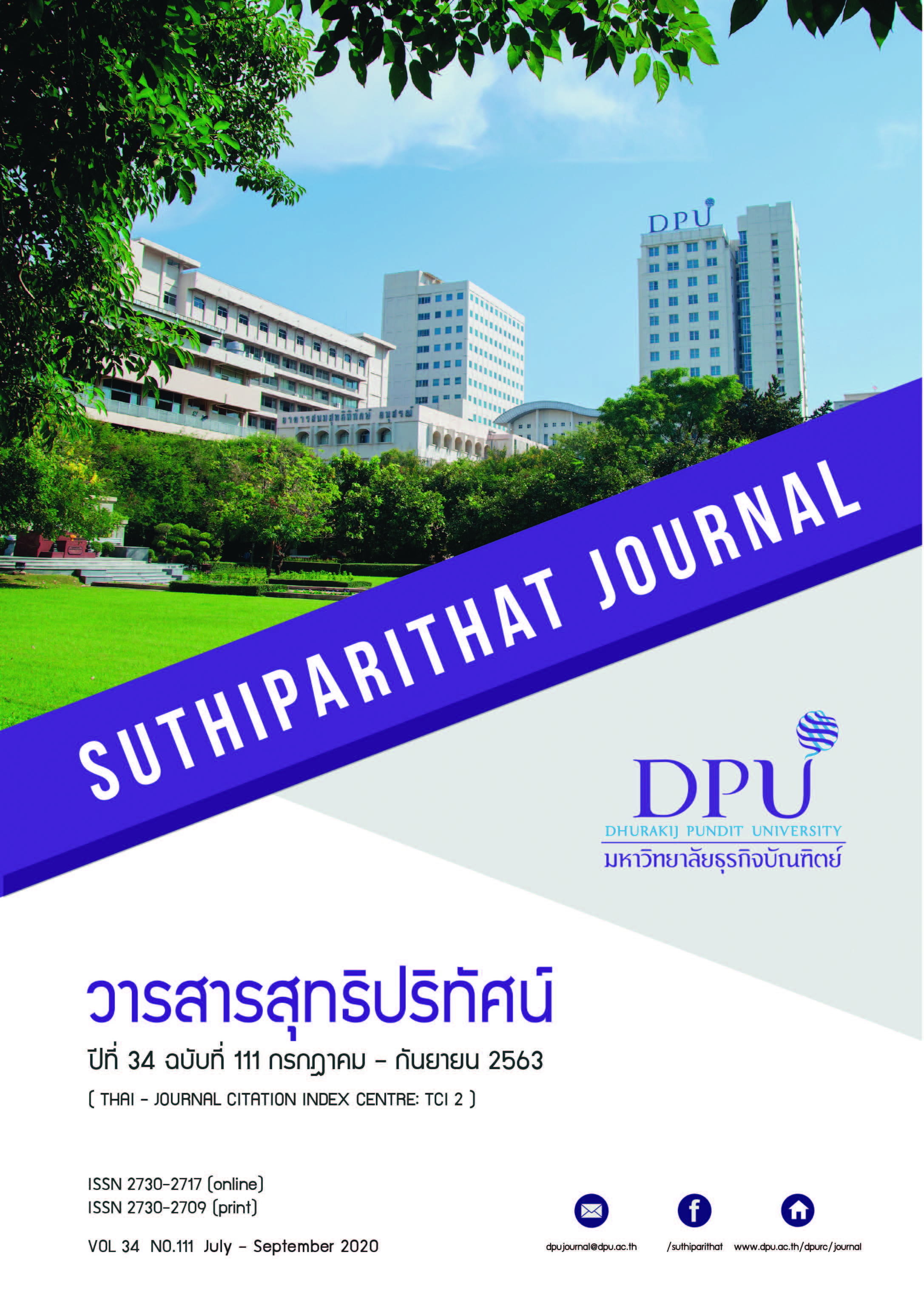บทบาทของส่วนประสมการตลาด 7Ps และการรับรู้คุณภาพที่ส่งผลต่อความพึงพอใจของลูกค้าและความภักดีของลูกค้าในการให้บริการดูแลเพื่อการพัฒนาเด็กปฐมวัยในประเทศพม่า
คำสำคัญ:
ส่วนประสมการตลาด 7Ps, การรับรู้คุณภาพ, ความพึงพอใจของลูกค้า, ความภักดีของลูกค้าบทคัดย่อ
วัตถุประสงค์หลักของการศึกษาในครั้งนี้คือ เพื่อวิเคราะห์ส่วนผสมทางการตลาดของ 7Ps และการรับรู้คุณภาพการบริการที่ส่งผลต่อความพึงพอใจของลูกค้าที่มีต่อความภักดีของลูกค้าในบริการ ดูแลส่วนตัวสำหรับการพัฒนาเด็กปฐมวัยในเมียนมาร์ ผลการวิจัยพบว่า สถานที่ หลักฐานทางกายภาพ ความน่าเชื่อถือและความสามารถ มีความสัมพันธ์อย่างมีนัยสำคัญกับความพึงพอใจของลูกค้า นอกจากนี้ ผลการวิจัยยังแสดงให้เห็นถึง ผลิตภัณฑ์ ผู้คน หลักฐานทางกายภาพและการเอาใจใส่ ได้รับการยืนยันว่ามีอิทธิพลทางสถิติต่อความภักดีของลูกค้า การศึกษานี้ทำให้เข้าใจได้ดีขึ้นว่า ความสำคัญของส่วนผสมทางการตลาดของ 7Ps และการรับรู้ผลกระทบด้านคุณภาพต่อความพึงพอใจของลูกค้า ต่อความภักดีของลูกค้ามากเพียงใด ในท้ายที่สุดกลยุทธ์การตลาดที่หลากหลายสามารถกำหนดได้ตามนั้น ในส่วนของส่วนผสมทางการตลาดของ 7Ps ช่วยให้ผู้จัดการกลายเป็นผู้นำ และความเชี่ยวชาญในสาขาการศึกษาระดับต้น การศึกษานี้แนะนำให้ใช้กับส่วนผสมทางการตลาดของ 7Ps (รวมถึงผลิตภัณฑ์ ราคา สถานที่ บุคคล หลักฐานทาง กายภาพ กระบวนการและการส่งเสริมการขาย) และคุณภาพที่สามารถรับรู้ (รวมถึงสิ่งที่จับต้องได้ ความน่าเชื่อถือ ความสามารถต่อการตอบสนองและการเอาใจใส่) สำหรับผู้จัดการที่มีต่อลูกค้า ความพึงพอใจต่อความภักดีของลูกค้าในบริการ การดูแลเด็กปฐมวัยในพื้นที่สภาของเนปิดอ ประเทศเมียนมาร์ การมีส่วนร่วมของทฤษฎี และผลกระทบสำหรับผู้จัดการจะกล่าวถึงในการศึกษาครั้งนี้
เอกสารอ้างอิง
Aaker, D. (1991). Managing brand equity. New York: The Free press.
Almsalam, S. (2014). The effects of customer expectation and perceived service quality on customer satisfaction. International Journal of Business and Management Invention, 3(8), 79-84.
Auka, Daniel Onwonga, Bosire, Joseph N., & Matern, Victor. (2013). Perceived service quality and customer loyalty in retail banking In Kenya. British Journal of Marketing Studies, 1(3), 32-61.
Duc Nha Le, Hong Thi Nguyen, & Phuc Hoang Truong. (2019). Port logistics service quality and customer satisfaction: Empirical evidence from Vietnam. The Asian Journal of Shipping and Logistics, 36(2).
El-Adly, M. I. (2019). Modelling the relationship between hotel perceived value, customer satisfaction, and customer loyalty. Journal of Retailing and Consumer Services, 50, 322–332. https://doi.org/10.1016/j.jretconser.2018.07.007
Goi, C. L. (2009). A review of marketing mix: 4Ps or more?. International Journal of Marketing Studies, 1(1), 1-15.
Hashim, N., & Hamzah, M. I. (2014). 7P’s: A literature review of islamic marketing and contemporary marketing mix. Procedia - Social and Behavioral Sciences, 130, 155–159. https://doi.org/10.1016/j.sbspro.2014.04.019
Jessie, J. Wang, & Ashok K. Lalwani. (2018). The distinct influence of power distance perception and power distance values on customer satisfaction in response to loyalty programs. International Journal of Research in Marketing, 36. doi: 10.1016/j.ijresmar.2018.11.006
Libent, D. (2015). Deterninants of parents’ satisfaction with the quality of pre-primary education in Ilala District, Dar Es Salaam Region, Tanzania. Tanzania.
Song, M., & Noone, B. M. (2017). The moderating effect of perceived spatial crowding on the relationship between perceived service encounter pace and customer satisfaction. International Journal of Hospitality Management, 65, 37–46. https://doi.org/10.1016/j.ijhm.2017.06.005
Oswald A. Igaua, Abdul Wahid Bin Mohd Kassim, Abdullah Kaid Al-Swidib, & Amran Bin Haruna. (2013). The effect of perceived value on brand loyalty and mediated by customer satisfaction: A case of hand phone users. Malaysia: College of Business, Universiti Utara Malaysia.
Souar, Y., Mahi, K., & Ameur, I. (2015). The impact of marketing mix elements on customer loyalty for an Algerian Telecommunication Company. Expert Journal of Marketing, 3(1), 1–10.
ดาวน์โหลด
เผยแพร่แล้ว
รูปแบบการอ้างอิง
ฉบับ
ประเภทบทความ
สัญญาอนุญาต
เนื้อหาและข้อมูลในบทความที่ลงตีพิมพ์ในวารสารสุทธิปริทัศน์ ถือเป็นข้อคิดเห็นและความรับผิดชอบของผู้เขียนบทความโดยตรงซึ่งกองบรรณาธิการวารสาร ไม่จำเป็นต้องเห็นด้วย หรือร่วมรับผิดชอบใด ๆ
บทความ ข้อมูล เนื้อหา รูปภาพ ฯลฯ ที่ได้รับการตีพิมพ์ในวารสารสุทธิปริทัศน์ ถือเป็นลิขสิทธิ์ของวารสารสุทธิปริทัศน์หากบุคคลหรือหน่วยงานใดต้องการนำทั้งหมดหรือส่วนหนึ่งส่วนใดไปเผยแพร่ต่อหรือเพื่อกระทำการใด ๆ จะต้องได้รับอนุญาตเป็นลายลักษณ์อักษรจากวารสารสุทธิปริทัศน์ก่อนเท่านั้น







